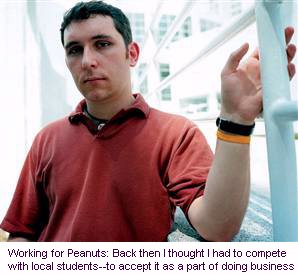 MSNBC.com MSNBC.com |
This article originally appeared online at http://www.msnbc.msn.com/id/9287027/site/newsweek/ |

 MSNBC.com MSNBC.com |
This article originally appeared online at http://www.msnbc.msn.com/id/9287027/site/newsweek/ |

It was 2002, and I had just opened my own graphic-design studio in my basement, where I was working with two old friends. Back then, I thought I had to compete with local students—to accept it as just another part of doing business. Now I find myself at one of Atlanta's premier art colleges, standing at a podium and teaching those very same students.
In my small, windowless classroom, in front of a baker's dozen of powerful G5 computers that line the walls, sit tomorrow's crop of great graphic designers, illustrators, filmmakers and animators. But despite their skills, their burgeoning individual styles and their unlimited creativity, they are crippled by the narrow focus of their education.
It took me a couple of years out of college to realize that my own B.A. in history was an asset. I landed my first salaried job during the heady days of unstoppable Internet growth, when the fact that I hadn't gone to art school was no impediment to getting hired as a senior Web specialist at a studio. Then the World Trade Center was attacked, and suddenly, I was answering questions about Islam, oil policy and our government's struggle against a new enemy for my colleagues—degreed artists all—who didn't understand the basic issues of the day.
As surprised as I was by their lack of knowledge, I was even more shocked by how helpless they were in light of our impending unemployment. The tech bubble had burst several months before 9/11, and our company, like many, was discarding its creative services staff to buoy sagging growth. My colleagues were unprepared to manage their own work—not as artists, but as businesspeople.
Unlike most college and university educations, art-school curricula do not revolve around math and language, writing and economics. Instead, they revolve around fundamental artistic principles such as color and light, figure and still-life drawing, basic electronic arts and art history.
What about creative business and copyright law? What about intellectual rights and business ethics? For that matter, what about basic history or civics? In a field largely defined by individual inspiration and accomplishment, where is the foundation for personal and financial success? Perhaps in an attempt to compensate for public schools which have stripped their curricula of arts education, art schools have left their graduates unprepared for the real world.
During my first semester as a teacher, I noticed a hunger in my students—a drive to crack the marketplace and build a portfolio, not just of teacher-assigned projects, but of real work for real clients. I also imagined I saw the threat in their eyes that my old boss saw in mine when I resigned to start my own company: "I can do this better than you ... and for less." It wasn't long before I realized that what I was seeing was simply untrained enthusiasm.
Now, a couple of semesters under my belt, I've learned how to get the kids excited not just about art, but about succeeding as businesspeople. I squeeze as much business education into my courses as my required curriculum will allow. I lead my students in roundtable discussions and offer anecdotes from my own experience. I use whole lectures to give them primers on service pricing, contracting, good business practices and copyright protection. I teach them to fight the tendency that lingers in all artists to give their art away. I tell them that their art is a specialty, not a commodity, and that they deserve to get paid for it.
But what can one professor do? These kids should have to take business education as a freshman requirement to learn how to manage their artistic enterprises before their enthusiasm sweeps them into a depreciated marketplace.
It took me a long time to learn how to answer that prospective client's $35 challenge. A long time before I learned to say, "You get what you pay for," and walk away.
My students often ask me what they should charge for the work they do outside of class. I help them come up with a fair estimate, then tell them the story about Carolyn Davidson, the Portland State University student whom Nike paid $35 for its "swoosh" logo in 1971. (Years later, the company gave her an undisclosed amount of stock.) I tell them about the calls I still get, clients trying to drive down my rates with "Any student will do it for $35 and a six-pack."
I tell them not to be that student—that it hurts our industry and that it'll hurt them in the long run, when they're in my shoes.
© 2005 MSNBC.com